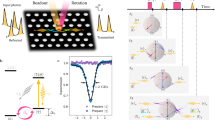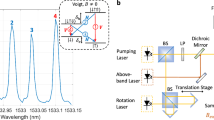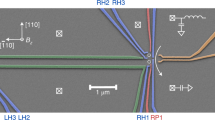Abstract
Quantum entanglement emerges naturally in interacting quantum systems and plays a central role in quantum information processing1,2,3,4. But the generation of entanglement does not require direct interactions: single-photon detection in spin-flip Raman scattering projects two distant spins onto a maximally entangled state, provided that it is impossible to determine the source of the detected photon5. Here, we demonstrate such heralded quantum entanglement6,7,8,9 of two quantum-dot hole spins separated by 5 m using single-photon interference. Thanks to fast spin initialization in 10 ns, hole-spin coherence lasting ∼40 ns and efficient photon extraction from dots10,11,12 embedded in leaky microcavity structures, we generate 2,300 entangled spin pairs per second, which represents a 1,000-fold improvement as compared to previous experiments13. The delayed two-photon interference scheme we developed allows the efficient verification of quantum correlations. Combined with schemes for transferring quantum information to a long-lived memory qubit14, fast entanglement generation could impact quantum repeater architectures.
This is a preview of subscription content, access via your institution
Access options
Subscribe to this journal
Receive 12 print issues and online access
$259.00 per year
only $21.58 per issue
Buy this article
- Purchase on SpringerLink
- Instant access to full article PDF
Prices may be subject to local taxes which are calculated during checkout



Similar content being viewed by others
References
Nielsen, M. A. & Chuang, I. L. Quantum Computation and Quantum Information (Cambridge Univ. Press, 2000).
Briegel, H.-J., Dür, W., Cirac, J. I. & Zoller, P. Quantum repeaters: the role of imperfect local operations in quantum communication. Phys. Rev. Lett. 81, 5932–5935 (1998).
Childress, L., Taylor, J. M., Sørensen, A. S. & Lukin, M. D. Fault-tolerant quantum communication based on solid-state photon emitters. Phys. Rev. Lett. 96, 070504 (2006).
Kimble, H. J. The quantum internet. Nature 453, 1023–1030 (2008).
Cabrillo, C., Cirac, J. I., García-Fernández, P. & Zoller, P. Creation of entangled states of distant atoms by interference. Phys. Rev. A 59, 1025–1033 (1999).
Moehring, D. L. et al. Entanglement of single-atom quantum bits at a distance. Nature 449, 68–71 (2007).
Hofmann, J. et al. Heralded entanglement between widely separated atoms. Science 337, 72–75 (2012).
Slodicka, L. et al. Atom-atom entanglement by single-photon detection. Phys. Rev. Lett. 110, 083603 (2013).
Bernien, H. et al. Heralded entanglement between solid-state qubits separated by three metres. Nature 497, 86–90 (2013).
Gao, W. B., Fallahi, P., Togan, E., Miguel-Sanchez, J. & Imamoğlu, A. et al. Observation of entanglement between a quantum dot spin and a single photon. Nature 491, 426–430 (2012).
De Greve, K. et al. Quantum-dot spin-photon entanglement via frequency downconversion to telecom wavelength. Nature 491, 421–425 (2012).
Shaibley, J. R. et al. Demonstration of quantum entanglement between a single electron spin confined to an InAs quantum dot and a photon. Phys. Rev. Lett. 110, 167401 (2013).
Hucul, D. et al. Modular entanglement of atomic qubits using photons and phonons. Nature Phys. 11, 37–42 (2015).
Meyer, H. M. et al. Direct photonic coupling of a semiconductor quantum dot and a trapped ion. Phys. Rev. Lett. 114, 123001 (2015).
Brunner, D. et al. A coherent single-hole spin in a semiconductor. Science 325, 70–72 (2009).
De Greve, K. et al. Ultrafast coherent control and suppressed nuclear feedback of a single quantum dot hole qubit. Nature Phys. 7, 872–878 (2011).
Greilich, K., Carter, S. G., Kim, D., Bracker, A. S. & Gammon, D. Optical control of one and two hole spins in interacting quantum dots. Nature Photon. 5, 702–708 (2011).
Carter, S. G. et al. Strong hyperfine-induced modulation of an optically driven hole spin in an InAs quantum dot. Phys. Rev. B 89, 075316 (2014).
Gazzano, O. et al. Bright solid-state sources of indistinguishable single photons. Nature Commun. 4, 1425 (2013).
Xu, X. et al. Fast spin state initialization in a singly charged InAs-GaAs quantum dot by optical cooling. Phys. Rev. Lett. 99, 097401 (2007).
Atatüre, M. et al. Quantum-dot spin-state preparation with near-unity fidelity. Science 312, 551–553 (2006).
Bayer, M. et al. Fine structure of neutral and charged excitons in self-assembled In(Ga)As/(Al)GaAs quantum dots. Phys. Rev. B 65, 195315 (2002).
Hong, C. K., Ou, Z. Y. & Mandel, L. Measurement of subpicosecond time intervals between two photons by interference. Phys. Rev. Lett. 59, 2044–2046 (1987).
Loudon, R. The Quantum Theory of Light (Oxford Univ. Press, 2000).
Matthiesen, C., Vamivakas, A. N. & Atatüre, M. Subnatural linewidth single photons from a quantum dot. Phys. Rev. Lett. 108, 093602 (2012).
Fernandez, G., Volz, T., Desbuquois, R., Badolato, A. & Imamoğlu, A. Optically tunable spontaneous Raman fluorescence from a single self-assembled InGaAs quantum dot. Phys. Rev. Lett. 103, 087406 (2009).
Robledo, L. et al. High-fidelity projective read-out of a solid-state spin quantum register. Nature 477, 574–578 (2011).
Weiss, K. M., Elzerman, J. M., Delley, Y. L., Miguel-Sanchez, J. & Imamoğlu, A. Coherent two-electron spin qubits in an optically active pair of coupled InGaAs quantum dots. Phys. Rev. Lett. 109, 107401 (2012).
Reithmaier, G. et al. On-chip time resolved detection of quantum dot emission using integrated superconducting single photon detectors. Sci. Rep. 3, 1901 (2013).
Arcari, M. et al. Near-unity coupling efficiency of a quantum emitter to a photonic crystal waveguide. Phys. Rev. Lett. 113, 093603 (2014).
Acknowledgements
The Authors acknowledge many useful discussions with M. Kroner. This work is supported by NCCR Quantum Photonics (NCCR QP), the research instrument of the Swiss National Science Foundation (SNSF), and by the Swiss NSF under Grant No. 200020-159196.
Author information
Authors and Affiliations
Contributions
All authors contributed extensively to this work.
Corresponding author
Ethics declarations
Competing interests
The authors declare no competing financial interests.
Supplementary information
Supplementary information
Supplementary information (PDF 1523 kb)
Rights and permissions
About this article
Cite this article
Delteil, A., Sun, Z., Gao, Wb. et al. Generation of heralded entanglement between distant hole spins. Nature Phys 12, 218–223 (2016). https://doi.org/10.1038/nphys3605
Received:
Accepted:
Published:
Issue date:
DOI: https://doi.org/10.1038/nphys3605
This article is cited by
-
A diamond nanophotonic interface with an optically accessible deterministic electronuclear spin register
Nature Photonics (2024)
-
Applications of single photons to quantum communication and computing
Nature Reviews Physics (2023)
-
Quantum networks with neutral atom processing nodes
npj Quantum Information (2023)
-
Coherent memory for microwave photons based on long-lived mechanical excitations
npj Quantum Information (2023)
-
Ideal refocusing of an optically active spin qubit under strong hyperfine interactions
Nature Nanotechnology (2023)



